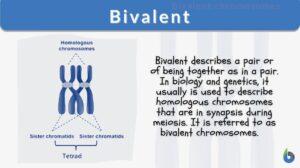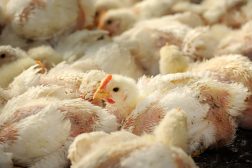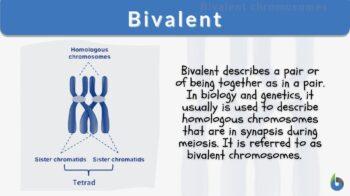
Bivalent
adj., n., [ˈbɪvələnt]
Definition: of, or relating to, a pair, such as of homologous chromosomes in synapsis, especially during meiosis
Table of Contents
Bivalent Definition
What is bivalent? In genetics, bivalent is used in describing homologous chromosomes (referred to as bivalent chromosomes) that are in synapse during meiosis. During the prophase of meiosis I, two chromosomes coming from each of the parents are joined at the synapse. The resultant bivalent chromosomes have two chromosomes and have four arms or chromatids. Thus in a bivalent chromosome, homologous chromosomes pair up and form a tetrad. The structure of a bivalent chromosome is represented in Figure 1.
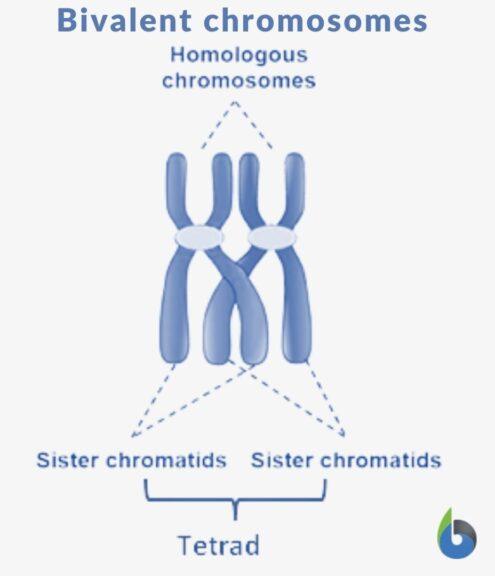
What is bivalent in chemistry? Bivalent is a term used to refer to the element having a valency of two. Such elements are also known as divalent.
What is bivalent in immunology? Bivalent is used to describe an antibody, in particular, that has two combining sites, and thus, is capable of binding to two molecules of an antigen. Bivalent, in the vaccine, describes the vaccine that can induce an immunological response (i.e., the production of antibodies) in the body against two different antigens, microorganisms, or viruses. The Cervarix vaccine is an example of a bivalent vaccine that is administered for two different strains of the human papillomaviruses (HPV).
The term, bivalents, is used in biology, chemistry, and vaccine research in different contexts. However, herein we will restrict our discussion concerning the usage of the term ‘bivalent’ in genetics.
Formation
A bivalent chromosome is a set of two chromosomes wherein one of the chromosomes comes from the maternal homologue inherited from the female gamete while the other chromosome is from the paternal homologue inherited from the male gamete.
The formation of the bivalent during meiosis occurs at prophase I of meiosis I. Depending upon the state of the chromosomes, meiosis is divided into five different stages namely,
Bivalent chromosomes are formed during the pachytene stage of the prophase I phase of meiosis. The formation of bivalent chromosomes essentially involves two homologous chromosomes coming together side by side, lengthwise. The two homologous chromosomes are held together at a point that is referred to as chiasmata (Figure 2). This results in the formation of bivalent chromosomes having four arms or chromatids and hence also referred to as the tetrad stage.
The formation of bivalent chromosomes is a critical step in meiosis as it provides the platform for the process of ‘crossing over’ wherein, two adjacent non-sister chromatids exchange the genetic material. The formation of chiasmata is indicative of the ‘crossing over’ between non-sister chromatids of the chromosome. Crossing over is the critical process that occurs during meiosis and is responsible for genetic diversity in the population.
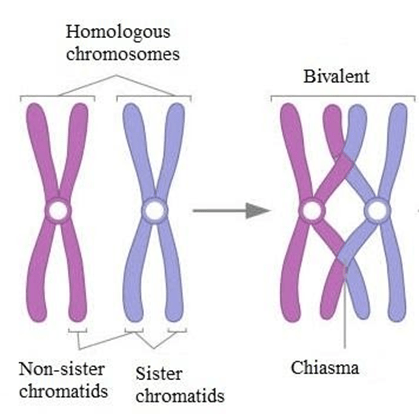
Here it is essential to understand the minor difference between ‘bivalent’ and ‘tetrad’. Bivalent is referred to the set of two homologous chromosomes lying adjacent to each other and are held together at chiasmata while tetrad is referred to the four arms (or the four chromatids) of the two homologous chromosomes of the bivalent. Both the terms are indicative of the same stage of the meiosis; however bivalent is used for the two homologous chromosomal sets while tetrad refers to the four chromatids in the bivalent chromosomes.
Biology definition:
Bivalent is a term describing or pertaining to a pair of homologous chromosomes in synapsis during meiosis, particularly at Prophase I of Meiosis I. Etymology: bi- (two) + valent from valence. Synonym: polyvalent. Compare: valence
Structure
Meiosis (a type of cell division) is essential for the formation of haploid gametes. During the prophase of meiosis I, homologous chromosomes are organized in a set of two forming a bivalent chromosome. The non-sister chromatids in the bivalent chromosomes will then undergo crossing over at the synapse via the synaptonemal complex (SC) (Figure 3).
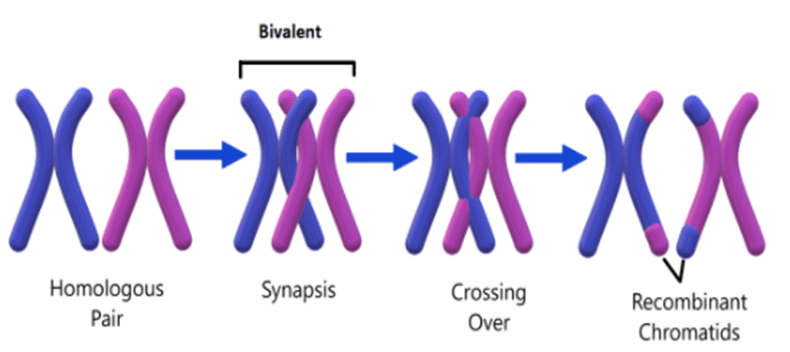
However, for the crossing over to occur, bivalent chromosomes undergo condensation to form a compact structure. The SC is composed of highly conserved proteins that mediate the physical connection between the two non-sister chromatids. Two lateral elements connected by protein results in the formation of a zipper-like structure in the SC. This zipper-like structure holds the non-sister chromatids until the crossing-over phenomena take place. Once the crossing over is finished, disassembly of the chromatids is initiated by the SC.
Function
The formation of bivalent chromosomes is the primary requisite for the crossing-over phenomena to occur during meiosis cell division. Crossing over is the process that results in the genetic diversity in the population, hence the formation of bivalent chromosomes is critical.
It is also important to understand that the proper formation of the bivalent chromosome is critical, as any defect in the formation of the bivalent chromosome may result in genetic defects in the offspring like embryonic lethality or inappropriate chromosome segregation, or birth defect.
In jist, it can be summed up that the whole purpose of the formation of the bivalent chromosomes is the exchange of the genetic material between non-sister chromatids of a homologous pair of chromosomes and equal distribution and segregation of the genetic information to bring about diversity in the population.
Try to answer the quiz below to check what you have learned so far about bivalent.
References
- Clemons, A. M., Brockway, H. M., Yin, Y., Kasinathan, B., Butterfield, Y. S., Jones, S. J., Colaiácovo, M. P., & Smolikove, S. (2013). akirin is required for diakinesis bivalent structure and synaptonemal complex disassembly at meiotic prophase I. Molecular biology of the cell, 24(7), 1053–1067. https://doi.org/10.1091/mbc.E12-11-0841
- Mercier, R., Mézard, C., Jenczewski, E., Macaisne, N., & Grelon, M. (2015). The molecular biology of meiosis in plants. Annual review of plant biology, 66, 297–327. https://doi.org/10.1146/annurev-arplant-050213-035923
- Moore, D. P., & Orr-Weaver, T. L. (1998). Chromosome segregation during meiosis: building an unambivalent bivalent. Current topics in developmental biology, 37, 263–299. https://doi.org/10.1016/s0070-2153(08)60177-5
- Tres L. L. (2005). XY chromosomal bivalent: nucleolar attraction. Molecular reproduction and development, 72(1), 1–6. https://doi.org/10.1002/mrd.20334
- Vergés, L., Blanco, J., Valero, O., Vidal, F., & Sarrate, Z. (2014). Chromosome size, morphology, and gene density determine bivalent positioning in metaphase I human spermatocytes. Fertility and sterility, 101(3), 818–824. https://doi.org/10.1016/j.fertnstert.2013.11.013
©BiologyOnline.com. Content provided and moderated by Biology Online Editors.

